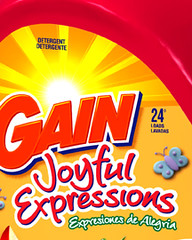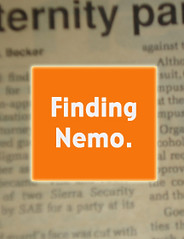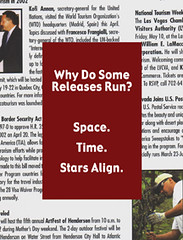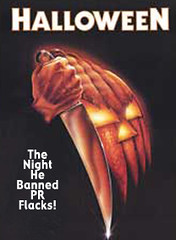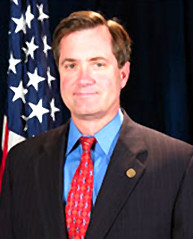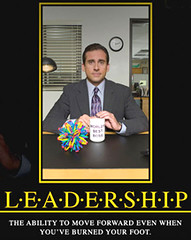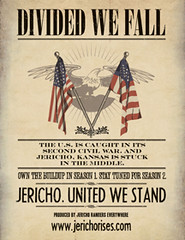When the Los Angeles Times asked Michael Colton and John Aboud, the writing team behind the Best Week Ever, how to shut down a television shoot, rallying Jericho fans took the number one spot, just ahead of telling a “Teamster that Jeff Zucker made fun of his mom.” Why Jericho fans?
“They brought a show back, they can take one out.”
While the top seven ways to stop a shoot was comedic (allowing Hugh Jackman to sing made the list), it might make some sense. The writers strike could be the perfect opportunity for Jericho fans to stop taking each other out on the CBS Jericho message boards, and begin to building a fan effort in support of the writers.
Such a move would only increase the exposure of the show before it returns in January by engaging all television fans about something they are passionate about. Fan crossover is somewhat proven to work. For the most part, there has been continuing cross over between the fans of Veronica Mars, Supernatural, and Jericho.
Each engagement between Jericho fans and other fans of any other show that is suddenly in the same boat might give Jericho a real shot at capturing January ratings. Yes, I said January. So far, CBS has no plans to bring Jericho back any earlier, which is good news for the fans. When I ran into BlogTalkRadio host Shaun Daily at BlogWorldExpo yesterday, he even said Jericho producer Carol Barbee was of the same thinking.
An early return of Jericho, especially in light of the writers strike, would mean immediate reinstatement on an arbitrary night and virtually no promotion. If fans focus on a January return, and perhaps help striking writers, they have two months to ramp up their show and build awareness with, well, anyone who also has a fan stake in the strike, regardless of what CBS does or doesn’t do.
Why would fans want to support the writers? The way I see it, fans can listen to the case as it was made by United Hollywood on YouTube or simply consider the reality of this strike. If the strike runs too long, many shows will not be coming back or, at best, may come back on a bubble.
According to the Dallas Morning News, the biggest loser of the 22-week strike in 1988 was broadcast television. It lost an estimated 10 percent of its network viewers.
Not only were those viewers lost forever, some shows did not survive. Nowadays, 10 percent can make the difference between a hit and a miss. In fact, an 18 percent drop after a much shorter break was enough for CBS to cancel Jericho in the first place.
Besides, Jericho fans may even have the best message if they were so inclined. What’s that?
Stop paying writers peanuts.

“They brought a show back, they can take one out.”
While the top seven ways to stop a shoot was comedic (allowing Hugh Jackman to sing made the list), it might make some sense. The writers strike could be the perfect opportunity for Jericho fans to stop taking each other out on the CBS Jericho message boards, and begin to building a fan effort in support of the writers.
Such a move would only increase the exposure of the show before it returns in January by engaging all television fans about something they are passionate about. Fan crossover is somewhat proven to work. For the most part, there has been continuing cross over between the fans of Veronica Mars, Supernatural, and Jericho.
Each engagement between Jericho fans and other fans of any other show that is suddenly in the same boat might give Jericho a real shot at capturing January ratings. Yes, I said January. So far, CBS has no plans to bring Jericho back any earlier, which is good news for the fans. When I ran into BlogTalkRadio host Shaun Daily at BlogWorldExpo yesterday, he even said Jericho producer Carol Barbee was of the same thinking.
An early return of Jericho, especially in light of the writers strike, would mean immediate reinstatement on an arbitrary night and virtually no promotion. If fans focus on a January return, and perhaps help striking writers, they have two months to ramp up their show and build awareness with, well, anyone who also has a fan stake in the strike, regardless of what CBS does or doesn’t do.
Why would fans want to support the writers? The way I see it, fans can listen to the case as it was made by United Hollywood on YouTube or simply consider the reality of this strike. If the strike runs too long, many shows will not be coming back or, at best, may come back on a bubble.
According to the Dallas Morning News, the biggest loser of the 22-week strike in 1988 was broadcast television. It lost an estimated 10 percent of its network viewers.
Not only were those viewers lost forever, some shows did not survive. Nowadays, 10 percent can make the difference between a hit and a miss. In fact, an 18 percent drop after a much shorter break was enough for CBS to cancel Jericho in the first place.
Besides, Jericho fans may even have the best message if they were so inclined. What’s that?
Stop paying writers peanuts.









